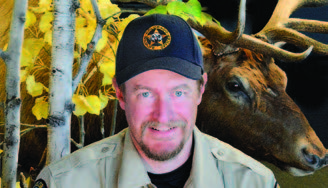
Aaron Berscheid is a district wildlife officer for Colorado Parks and Wildlife. Aaron covers the “wild” side of Northeast El Paso County, including Black Forest, Falcon, Peyton and Calhan. He also covers some of Elbert County, north of U.S. Highway 24 and south of State Highway 86, including the towns of Elbert, Kiowa, Ramah, Simla, Matheson and a small portion of the Limon area.
Mountain lions are like big scaredy cats
By Aaron Berscheid
District Wildlife Manager, CPW
The lore surrounding mountain lions makes the truth about these creatures as elusive as the big cats themselves.
Many things about mountain lions can create a lot of fear that may or may not be warranted.
Mountain lions get a bad reputation because they are large, powerful predators that sneak around at night. In reality, I think of them as big scaredy cats that do everything they can to stay away from humans and the human presence.
Hopefully, I can give enough information to help anyone who might encounter a mountain lion to be more prepared and aware of how these animals work.
You may have seen reports on social media of mountain lion sightings in and around the Black Forest and Peyton areas.
It’s true, mountain lions do live in and around us. But there is not a very large population in the Black Forest/Peyton area, and actual sightings/encounters are very rare.
Typically, mountain lions spotted in the area are younger lions simply passing through as they search for their own territory after being kicked out of an adult lion’s domain.
The most important thing to know about mountain lions is that they are afraid of humans. Due to their innate fear of humans, they avoid us, making it very rare to see a mountain lion. Most sightings are caught on home security cameras and trail cameras.
Rare human encounters usually occur when someone accidentally crosses paths with a lion.
Want to ensure you don’t encounter a mountain lion? When you are in a heavily wooded area or an area where mountain lions are known to be seen, make lots of noise as you walk. And make sure that you appear to be large and not prey-like.
If you have pets with you, be sure they are leashed and also have noisemakers like bells attached.
Mountain lions are most active during dawn and dusk hours pursuing their natural prey, which includes rabbits, turkeys and deer. Lots of deer.
Mountain lions also may prey on small livestock and pets. So it is wise to protect your livestock (especially sheep, goats, chickens and llamas) by keeping them penned starting before dusk and through the night until after the dawn hours.
Small pets should be kept indoors during these same hours and held on a leash when they need to be let out at night.
As long as you take steps to protect livestock and pets, the likelihood of an issue with a mountain lion is very rare.
If you do happen to see a mountain lion, feel free to report it to our office and we will document these sightings. Any mountain lion issues with livestock should also be reported.
If you do encounter a lion, it is important to make yourself big and never run away, as this might trigger the lion’s instinctive reaction to chase you.
In the coming months, I’ll share more of those stories as I write about wildlife issues in our community: Got a question, problem or column idea, please email me at aaron.berscheid@state.co.us or call me at 719-227-5231.
I might even answer your question in a future installment of “Wildlife Matters.”




